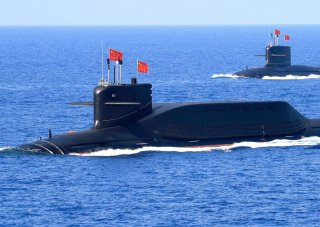China’s Type 094-Class Nuclear Missile Submarine: The Ultimate Paper Tiger?
Why not both?
China’s Type 094, or Jin-class nuclear submarines are capable, but they may be tools for promoting national prestige rather than true nuclear deterrence.
Jin-class
The Type 094, or Jin-class as it is also known, is operated by the People’s Liberation Army Submarine Force. The Jin-class is a ballistic missile submarine that has an onboard nuclear reactor for propulsion. It is China’s second generation of nuclear-powered submarines and is a direct successor to the Type 092, or Xia-Class of nuclear subs. The Jin-class was first launched in 2007, and became operational sometime in 2010. A total of 8 Jin-class hulls are believed to exist, though the class may ultimately grow to a total of 12 hulls.
JL-2
As ballistic missile submarine, the Jin-class is armed with nuclear ballistic missiles—the JL-2. The JL-2 is an improvement of the older JL-1 ballistic missile, which is in service aboard the older Type 092 ballistic missile submarines. It is bigger in both diameter and length, and has a greater ranger and bigger payload.
The JL-2’s range is estimated to be in the 8,000-9,000 kilometers, or approximately 5,000 to 5,600 miles. The warheads on the JL-2 are variable. It can be armed with a 1 megaton nuclear warhead, or several other lower-yield warheads.
Although the distance from Beijing to Los Angeles is over 10,000 miles, a Type 094 submarine on patrol near Alaska would be able to hit the majority of the United States with the JL-2. The Type 094 began conducting nuclear deterrence patrols sometime in 2015.
Silent
China’s defense industry is notoriously tight-lipped about advancements in weapon systems. It is therefore difficult to ascertain with an absolute degree of certainty how quiet the Jin-class really is. It has been suggested that the Jin-class may be quieter than the Typhoon-class—Russia’s quietest and most technologically advanced nuclear-powered ballistic missile submarine.
Still, the Jin-class may not yet be a Chinese wonder weapon. A report by this publication stated that the Jin-class may be detectable due to a design flaw at the rear of the hull near the missile hatches, which could create a detectable sonar signal.
Truth or Hype?
While most nuclear-equipped ballistic missile submarines rely on the ocean for survivability and ensure a second-strike capability, China’s strategy with the Jin-class may be a milder form of deterrence coupled with national prestige.
The nuclear submarine club is indeed a highly exclusive club—and those with nuclear ballistic missiles even more so. The real issue is how quiet the Jin-class is.
A report from the Office of Naval Intelligence stated that China’s Jin-class is the “first credible at-sea second-strike nuclear capability.” The Department of Defense concurred in a 2016 report stating that, “together these [the Jin-class and the JL-2 ballistic missile] will give the PLAN its first credible long-range sea-based nuclear capability.”
Assuming that it is not as quiet as has been hyped, the Jin-class may serve as deterrence in a local theater of conflict (i.e., the South China Sea), rather than as a truly global nuclear deterrence tool.
Caleb Larson holds a Master of Public Policy degree from the Willy Brandt School of Public Policy. He lives in Berlin and writes on U.S. and Russian foreign and defense policy, German politics, and culture.
Image: Reuters

